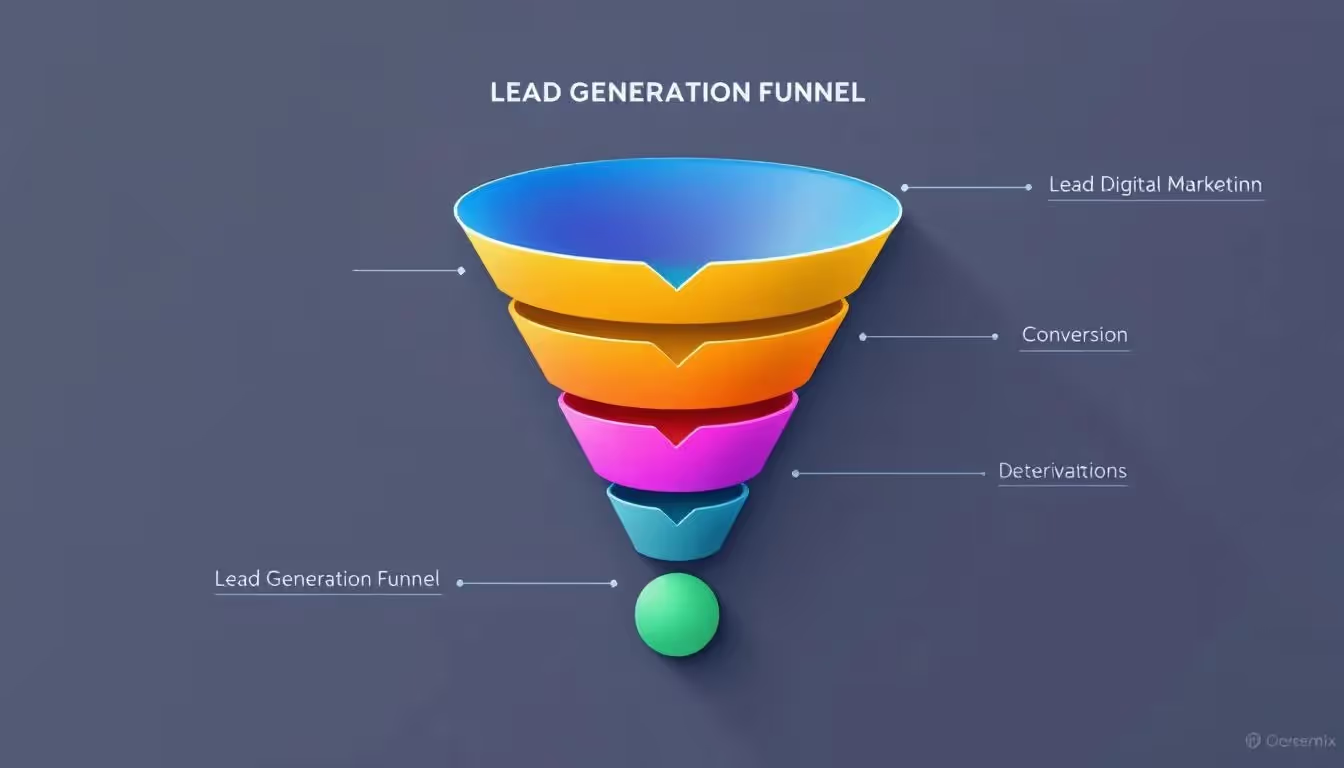How to Create a Powerful Lead Gen Funnel in 5 Easy Steps
A lead gen funnel is a method to turn prospects into paying customers by guiding them through a series of tailored steps. It’s crucial for consistent customer conversion and business growth. This article will show you how to build an effective lead gen funnel in five simple steps.
Key Takeaways
- A lead generation funnel consists of three key stages: awareness, consideration, and decision, each crucial for converting potential customers into loyal clients.
- Creating a powerful lead gen funnel involves identifying your target audience, developing compelling lead magnets, and utilizing marketing automation tools for effective engagement.
- Continuous monitoring and optimization of the funnel are essential for driving conversions and adapting to market changes, with effective lead qualification and speed to lead being critical for success.
Understanding the Lead Gen Funnel

A lead generation funnel is the backbone of any successful marketing funnel strategy, designed to attract the right audience and convert them into paying customers. Think of it as a journey that guides potential leads through various stages, from initial awareness to final conversion. This systematic approach not only increases the likelihood of conversions but also enhances the overall customer experience by providing targeted and relevant interactions at each stage, including lead funnels, the traditional sales funnel, and a lead magnet funnel as part of a lead funnel strategy.
A well-defined lead generation funnel helps businesses maintain continuous revenue and increase brand awareness. Understanding and optimizing each stage allows for refining marketing strategies, ensuring a steady flow of high-quality leads, and ultimately driving more sales.
The different stages of a lead generation funnel each play a role in converting potential customers to convert potential customers into loyal clients.
Stages of a Lead Generation Funnel
Lead generation funnels consist of three main stages: awareness, consideration, and decision. Each stage plays a pivotal role in guiding potential leads through the customer journey, ensuring they receive the right information at the right time. Grasping these distinct stages helps marketers effectively capture leads and drive conversions.
During the awareness stage, your goal is to introduce potential customers to your brand and pique their interest in the buyer’s journey. The consideration stage involves nurturing these leads by providing valuable information and addressing their needs.
Finally, in the decision stage, you aim to convert these nurtured leads into paying customers by offering personalized solutions and compelling offers. Let’s delve deeper into each of these stages to understand how they contribute to a successful lead generation funnel.
Awareness Stage
The awareness stage is where potential customers first encounter your brand. At this point, the focus should be on addressing their problems rather than promoting your product directly. Content ideal for this stage includes:
- Blog posts
- Videos
- Organic social media updates
- Social media ads
These content types help generate awareness, drive traffic, and capture the attention of potential leads.
Engagement and initial interactions are crucial during the awareness stage. This could involve prospects browsing your website, reading your blogs, or watching your videos, including social media engagement. The main objective is to generate awareness and drive traffic to your site, preparing for further nurturing and eventual conversion.
Consideration Stage
In the consideration stage, potential leads are evaluating how well your product or service meets the needs of prospective customers. This stage often involves multiple touchpoints, as prospects gather information, contact customer service, and fill out forms for more details. Content such as product overviews, case studies, and educational guides are highly effective in this phase.
Ebooks, whitepapers, and case studies provide in-depth information that helps leads compare options and make informed decisions. Nurturing prospects at this stage keeps them engaged and moves them closer to a decision. Channels like email marketing, SEO, social media marketing, and marketing channels are effective for distributing content and engaging leads during the consideration stage.
The goal of content marketing tactics during this phase is to position your brand as the best choice over competitors. Inviting prospects to live webinars is a practical example of engaging and nurturing leads, providing them with valuable content while showcasing your expertise.
Decision Stage
During the decision stage, prospects are prepared to buy. This is the moment when they finalize their purchasing choice. At this point, personalized communication and offers become crucial to help them finalize their decision. Conversions happen at the bottom of the funnel, turning leads into paying customers. Sales teams play a significant role here, engaging with leads to facilitate the sales process, the buying process, and the sales pipeline.
Personalized interactions and limited-time offers can significantly influence the decision-making process. A personalized product demo or free trial can make the purchase feel non-committal, enticing leads to finalize their decision. Nurturing leads through personalized interactions, even at this stage, is essential to aid in their decision-making process. Additionally, offering free trials can further enhance this experience.
Personal preferences and immediate benefits heavily influence B2C consumers when making purchase decisions. By understanding these preferences and providing tailored offers, businesses can significantly improve their conversion rates and turn prospects into a loyal customer.
.jpg)
Building Your Lead Gen Funnel
Creating a successful lead generation funnel involves a dedicated and well-defined lead gen process. The ultimate goal is to generate high-quality leads and expand your customer base. The first step in building your lead funnel involves setting clear and achievable goals, which requires understanding your customer’s needs and behaviors to guide the design process.
There are five beginner-friendly steps to creating a lead-generation funnel:
- Identifying your target audience
- Creating compelling lead magnets
- Developing high-converting landing pages
- Implementing marketing automation
- Monitoring and optimizing your funnel.
Each of these steps will help you build a lead that is effective in generating a lead generation funnel that drives results.
Identify Your Target Audience
Understanding your target audience is crucial for tailoring your marketing efforts effectively. This involves analyzing existing customers to identify their pain points, needs, and aspirations. Factors to consider include:
- Age
- Gender
- Interests
- Challenges they face.
Creating detailed buyer personas that include job titles, goals, and preferred communication channels provides a comprehensive view of your ideal customers. A clear targeting strategy aligns your marketing efforts with the specific needs and behaviors of your target audience.
The first and most critical step in creating an effective lead generation funnel is identifying your target audience.
Create Compelling Lead Magnets
A lead magnet is a valuable resource or incentive offered in exchange for contact information. Lead magnets should provide solutions aligned with the interests and pain points of your target audience. Consider what will attract your ideal customers and resonate with their needs when creating a lead magnet.
Enhancing the perceived value of a lead magnet by offering done-for-you (DFY) resources instead of do-it-yourself (DIY) materials can significantly boost its effectiveness. The aim is to capture leads by offering something valuable in exchange for their contact information, generating high-quality leads for your sales funnel.
Develop High-Converting Landing Pages
Landing pages are designed to drive lead generation by clearly communicating the audience’s problem and offering the best solution. A clear plan for crafting a landing page guides creation and ensures effectiveness. Strong calls-to-action (CTAs) are crucial, as they guide prospects toward their next action and should be visually appealing and easy to spot.
A landing page must include a clear call-to-action to direct the visitor’s next steps. Enhancing conversions requires landing pages to have strong CTAs, minimal distractions, and a simple, focused design. Popular landing page builders like Convertkit, Unbounce, and Leadpages allow for quick creation, making them valuable for marketers.
After creating a lead magnet, it must be made available via a landing page to capture leads effectively. Landing pages must give a positive impression and appear professional to achieve high conversion rates.
.jpg)
Implement Marketing Automation
Marketing automation tools engage leads across multiple channels, delivering relevant information to encourage conversions. These tools assist in nurturing leads through automated email sequences, personalized content recommendations, and targeted ad campaigns. The purpose of marketing automation platforms is to streamline processes, automate tasks, and enable personalized campaigns.
Using automation tools can significantly enhance the efficiency of nurturing leads through personalized content and improve response times with features like lead notifications and live chat. Implementing marketing automation ensures timely and relevant engagement with leads, ultimately driving more conversions.
Monitor and Optimize Your Funnel
Tracking key metrics for each stage of the funnel is essential for understanding lead engagement and conversion effectiveness. Important funnel metrics to monitor include lead conversion rates and prospect behavior to gauge performance. Regular analysis of your funnel’s performance helps uncover bottlenecks and measure overall marketing impact.
If certain aspects of your lead generation funnel are underperforming, improve areas such as targeting, messaging, and CTAs. Strategies such as A/B testing campaigns can significantly enhance the effectiveness of your sales funnel.
Ongoing optimization of your funnel strategy ensures alignment with business goals and responsiveness to market changes.
Tools to Enhance Your Lead Gen Funnel
%20(1).jpg)
Choosing the right tools enhances the efficiency and effectiveness of your lead generation funnel. Consider your business budget and the tools’ effectiveness in capturing and nurturing leads when choosing lead generation tools. Lead generation tools can help you learn crucial details about potential leads, such as company information, time spent on web pages, and employee details.
Lead tracking tools offer visibility into lead interactions across various touchpoints, helping you understand their journey and optimize your new leads and convert leads b2b lead marketing efforts.
Let’s explore some essential tools that can elevate your lead generation efforts and streamline your funnel processes.
Leadspicker
Leadspicker is designed to supercharge lead generation and automate outreach. It helps businesses generate high-quality leads, automate outreach, and grow faster. Trusted by over 5,000 users at leading companies, Leadspicker adapts to various industries and roles, including freelancers, agencies, SaaS companies, and large enterprises.
Leadspicker offers AI-powered columns that enrich lead lists with job titles, emails, LinkedIn activity, and more. The Chrome extension streamlines prospecting by allowing users to add leads to outreach campaigns while browsing LinkedIn or job portals. Automating more than 95% of LinkedIn actions using its own infrastructure, Leadspicker significantly reduces the risk of restrictions.
CRM Software
CRM software centralizes customer data and interactions, optimizing nurturing and ensuring seamless transitions between funnel stages. These tools manage customer relationships from initial contact to post-sale support, enhancing communication and personalized interactions based on individual preferences and behaviors.
Examples of tools and their benefits include:
- Salesforce Engage: helps maintain and view a history of customer interactions
- Zendesk Sell: improves lead management by eliminating confusion
- Salesforce’s opportunity management: helps close deals faster, ensuring customers are engaged and nurtured at every funnel stage.
Analytics Tools
Analytics tools are essential for monitoring the performance and effectiveness of your lead generation efforts. Google Analytics, for instance, is a powerful tool that helps monitor traffic sources, providing insights into where leads are coming from. It also helps analyze user behavior, allowing businesses to understand how leads interact with their funnel.
Besides Google Analytics, CRM systems and Sales Analytics further enhance your ability to monitor and update your ideal customer profile. These tools provide valuable insights into market trends and customer interactions, helping you optimize your marketing efforts and improve lead generation outcomes through market research.
Best Practices for Lead Gen Funnel Success
%20(1).jpg)
Understanding leads, timely engagement, and diligent follow-up are crucial for effectively building a sales funnel. An email campaign in lead generation aims to inspire leads to become customers, not just to sell products. Informing and educating leads about products and services is essential after capturing their information.
Continuous experimentation is key for optimizing the lead funnel and ensuring effective lead generation. Experimenting to find what works best for their audience helps businesses improve lead generation efforts. Key areas to adjust based on audience changes include:
- Content types
- Advertising efforts
- Landing pages
- Sales strategies
Let’s explore some best practices to ensure the success of your lead generation funnel.
Qualify Leads Effectively
Effective lead qualification focuses your marketing efforts on genuinely interested qualified leads, optimizing resource allocation and improving conversion rates. This involves prioritizing leads based on their engagement with your content, such as their interactions with your website, emails, and social media channels. By focusing on the most promising opportunities, you can maximize your chances of converting high-quality leads into paying customers through lead nurturing.
Effective lead qualification involves a blend of marketing automation tools and human intuition. Utilize lead scoring models to rank leads based on their behavior and engagement levels, and ensure your sales team is aligned with these criteria to prioritize follow-ups. This strategy not only streamlines the lead management process but also enhances the efficiency of your sales funnel by ensuring that sales efforts are directed toward the most viable prospects.
Speed to Lead
In today’s fast-paced digital landscape, speed to lead is crucial for capitalizing on interest and converting potential leads into paying customers. The promptness with which businesses engage with potential leads after receiving inquiries can significantly impact conversion chances. Improving speed to lead involves setting up automated lead notifications and integrating live chat features.
Implementing these strategies ensures timely engagement with leads, making them feel valued and attended to. This quick response not only boosts conversion rates but also enhances the overall customer experience. By prioritizing speed to lead, businesses can effectively nurture leads, address their queries promptly, and guide them smoothly through the sales funnel.
Continuous Experimentation
Continuous experimentation is crucial for optimizing lead generation funnels and finding what resonates best with your audience. Regularly testing different components of your sales funnel, such as messaging, landing pages, and calls-to-action, can reveal valuable insights into what works and what doesn’t. This ongoing iteration leads to improved performance and a better understanding of audience preferences.
Encourage your marketing team to experiment with strategies, track conversion rate changes, and adjust accordingly. This proactive approach ensures that your marketing efforts remain aligned with consumer preferences and industry trends, ultimately enhancing the effectiveness of your lead generation funnel.
By fostering a culture of continuous improvement, businesses can stay ahead of the competition and consistently achieve their lead generation goals.
Summary
Creating a powerful lead generation funnel involves understanding its stages, building an effective process, utilizing the right tools, and adhering to best practices. By identifying your target audience, creating compelling lead magnets, developing high-converting landing pages, implementing marketing automation, and continuously monitoring and optimizing your funnel, you can ensure a steady flow of high-quality leads and drive more conversions.
Remember, the success of your lead generation efforts hinges on your ability to adapt and innovate. Embrace continuous experimentation, prioritize speed to lead, and qualify leads effectively to maximize your funnel’s performance. With these strategies in place, you’ll be well on your way to building a robust lead generation funnel that not only captures high-quality leads but also converts them into loyal customers. Stay committed, keep optimizing, and watch your business thrive!
Frequently Asked Questions
What is Leadspicker designed to do?
Leadspicker is designed to enhance lead generation and automate outreach, making it easier for businesses to connect with potential clients.
How many users trust Leadspicker?
Leadspicker is trusted by over 5,000 users at leading companies, indicating a strong level of confidence in its services.
What feature does Leadspicker offer for enriching lead lists?
Leadspicker enhances lead lists with AI-powered columns that provide valuable information such as job titles, emails, and LinkedIn activity. This feature significantly improves the quality of your lead data.
Can users cancel their Leadspicker subscription anytime?
Yes, users can cancel their Leadspicker subscription at any time through the 'Billing' section in their account settings.
Does Leadspicker offer a free trial?
Leadspicker does offer a free trial that provides access to key functionalities. This allows you to explore its features before committing.

.jpg)




